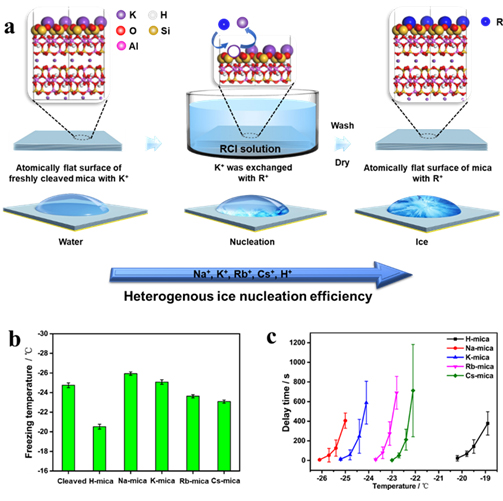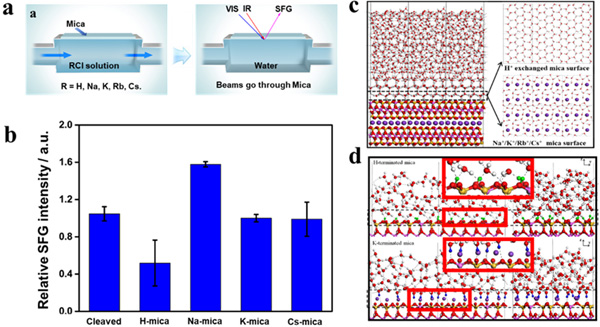Researchers Reveal the Mechanism of Heterogeneous Ice Nucleation Triggered by mineral Surfaces Typically Exposing to Various Ions
Heterogeneous ice nucleation (HIN) induced by mineral surfaces with various ions, is ubiquitous in nature. A better understanding of the mechanism underlying HIN on the nature of the mineral surface ions has directly implicated in numerous atmospheric processes including cloud formation, radiative budget and climate on earth, etc. However, the mechanism of ion-specific effect on the HIN is still inconclusive due to the complexity of mineral surfaces.
In a study reported in J. Am. Chem. Soc., the research group led by Prof. WANG Jianjun from the Institute of Chemistry, Chinese Academy of Sciences (ICCAS), the group led by Prof. ZENG Xiao Cheng from Department of Chemistry, University of Nebraska-Lincoln (USA) and the group led by Prof. Mischa Bonn from Max Planck Institute for Polymer Research (Germany) reported their success in revealing the mechanism underlying heterogeneous ice nucleation (HIN) triggered by mineral surfaces typically exposing to various ions.
In this study, muscovite mica was selected based on following considerations: 1) the K+ on the atomically flat (001) surface of mica can be readily replaced by different cations through ion exchange; 2) the simple nature of mica provides a very straightforward system that can serve as the model for investigating the effect of mineral surface ions on HIN.

The ion-specific effect on the HIN temperature of the water droplet on the surfaces (001) of various cation-embedded mica. (image by Prof. WANG Jianjun)
Through theoretical and experimental studies, the researchers found that the HIN efficiency of ions depends on the positional arrangement and orientation of the interfacial water. "The size of the protruding ions atop the mica surface and the surface adsorption energy determine whether the hexagonal ice Ih basal-type structure facilitating HIN in the first water layer atop the mica surface can form. The orientational distribution is optimal for HIN when 25% water molecules pointing down/up in the first water layer atop the mica surface, which is determined by the surface charge distribution." Prof. WANG says. "This comprehensive mechanistic study provides molecular-level insights into how the ion specificity of the mica (001) surface affects the HIN efficiency. Such insights will provide a better understanding of HIN on other mineral surfaces"

Molecular-level insight into HIN on mica surfaces. (image by Prof. WANG Jianjun)
The research was supported by National Key Research and Development Program of China, the National Natural Science Foundation of China, Key Research Program of Frontier Sciences, CAS, DFG, German Research Foundation and the ERC Starting Grant.
Contact:
Prof. WANG Jianjun
Institute of Chemistry, Chinese Academy of Sciences
Email: wangj220@iccas.ac.cn





